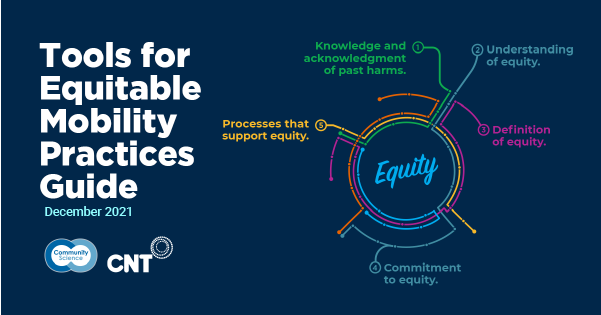Decisions in the transportation field have often harmed Black and brown communities: for example, freeway construction destroying Black and brown neighborhoods, federal funding policies for public transit that favor rail expansion to affluent suburban communities rather than urban transit service improvements, land use decisions that focus on polluting truck traffic in communities of color, and inequitable traffic law enforcement. To advance equity, we need to push transportation decisions in a different direction.
Increasingly, the leaders and staff of public agencies are looking for approaches to improve equity in their transportation decisions. The Barr Foundation commissioned Community Science in partnership with the Center for Neighborhood Technology (CNT) to develop a guide to respond to this need for promising practices in evaluating the equity impacts of policy decisions in the transportation field. The Tools for Equitable Mobility Practices Guide describes the landscape of existing equity assessment tools that apply to transportation and mobility decisions.
From our work, we have found that transportation agencies that have pioneered those tools share essential characteristics:
Knowledge and acknowledge of past harms. Before working to solve any problem, it is important to understand what the problem is, how it came to be, and who is impacted by the problem. To ensure that efforts to increase equity do not replicate past injustices, people and organizations need an understanding of the historical context and must be willing, to be honest about the harm that has been caused by transportation policies and programs.
Understanding of equity. Learn more about potential equitable solutions. All the tools in this guide rely on agencies having done quantitative work in their geographies to identify and measure transportation disparities and, even better, have determined indicators to measure transportation equity.
Definition of equity. Combine your understanding of current and past harms in your region with potential equitable solutions to define what doing better means in your community or agency. Start by defining the term equity, identifying principles, and setting goals through an inclusive process are early steps for an agency to advance equity.
Commitment to equity. Commit to doing the work. A public and authentic commitment to equity is needed at numerous levels, including leadership, board, and staff. Equally as important, there is a financial commitment to equity.
Processes that support equity. Infuse equity throughout your work so that you do not easily backtrack. Agencies that are ready for these types of tools have strong community engagement practices, experiences partnering with advocates and mobility justice groups, internal decision-making processes that ensure that equity is considered, established internal equity expertise, and a system for accountability.
In the guide, we highlight six promising tools for assessing equity impacts of transportation policy decisions and describe how and in what context these tools are implemented. We selected these tools in collaboration with industry leaders, funders, and advocates who are leading some of the promising practices in the field. Transportation agencies, at all levels, are the primary audiences for this guide, as they have the power and responsibility to change their behavior; advocates, organizers, and community groups can also use the guide to encourage their public agency partners to use the tools profiled.
Importantly, we also conclude that not every agency is ready to use these assessment tools. The characteristics noted above are preconditions for successful use – and agencies without these should take these earlier steps (described in more detail in the guide) toward equity before jumping into using the advanced tools profiled in our guide. Premature application of these tools, by agencies that are not truly committed to an equity framework, will turn the equity analysis into a performative exercise—causing more harm to communities of color and low-income communities.
Leaders and staff in these public agencies will have to confront the realities about the past and ongoing harms caused by transportation decision-makers. This means comprehensive tools for assessing the equity implications of new policies and programs need to be deeply integrated into decision-making processes and actions, and an explicit investment in building the capacity of agencies to implement equity tools in partnership with communities most impacted by transpiration policy decisions.
What to learn more? Click here to register for our webinar on Jan 25, 2022. We will host a panel of equity leaders from public agencies and advocacy organizations who have centered equity in their transportation policy decisions and actions. Hear their journeys. Learn from their experience. Click here to download a copy of the guide they helped to write.
Introduction to the Tools
Authors
Amber Trout, Managing Associate, at Community Science, a research and evaluation organization whose mission is to build healthy, just, and equitable communities through the science and practice of community and systems change. Prior to Community Science, Amber served as the director of the Race, Equity, Diversity, and Inclusion Initiative (REDI) at NeighborWorks America, and previously held positions as a community health practitioner in multiple communities.
Bob Dean is the Chief Executive Officer at the Center for Neighborhood Technology (CNT), a nonprofit organization that has advanced equity and sustainability since its founding in 1978. Prior to CNT, Bob led the planning department at the Chicago Metropolitan Agency for Planning (CMAP) for a decade, and previously held positions in municipal government.
Heidy Persaud, Director of Transportation joined CNT in 2020 to implement the agency’s work on transportation with a multidisciplinary and equitable focus. Prior to CNT, Heidy worked in urban planning and community development providing assistance to communities across the Chicago metropolitan area through plan-making, community outreach, partnership building, and implementation.
Amy Minzner, former Senior Associate at Community Science. Prior to joining Community Science, Amy was a Senior Associate at Abt Associates, where she evaluated multiple workforce development initiatives and capacity-building initiatives for federal agencies and foundations, and previously held positions as an urban and regional planner.

